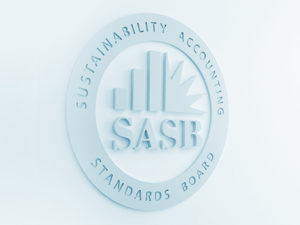
Marie-Josee Privyk, CFA, RIPC, FSA Credential Holder, ESG Advisor at FinComm Services, Lead of the Quebec SASB FSA Credential Group
The following guest blog was written by Marie-Josee Privyk, CFA, RIPC, FSA Credential Holder, ESG Advisor at FinComm Services and Lead of the Quebec SASB FSA Credential Group.
When the coronavirus crisis first erupted, it was very refreshing—and more than a little reassuring—to see that companies’ preoccupations were neither first, nor even mainly, about profits and liquidities, but about measures to protect their employees’ and customers’ health, secure working conditions, provide the flexibility of working remotely, maintain essential services and support their supply chains, and safeguard as many jobs as possible.
In parallel, investors very rapidly swung into “responsible investment action,” mobilizing and collaborating to make very specific recommendations to companies about what they expected from them in facing this crisis: maintaining as many jobs as possible and protecting wages, prioritising health and safety, collaborating with their suppliers, and demonstrating financial prudence and coherence—i.e. cutting dividends, halting share buyback programs, reducing executive remuneration, and paying their fair share of taxes. They also exhorted companies to stay the course on efforts to address climate change and biodiversity loss, noting the greater and longer-lasting effects of these “other” crises. (See, e.g., the PRI’s How Responsible Investors Should Respond to the Covid-19 Crisis or the Investor Statement on Coronavirus Response.)
The coronavirus crisis also provided strong empirical evidence of the connection between managing environmental, social, and governance (ESG) issues effectively and value creation—in this case, the link between human capital management and stock price performance and resilience—from sources such as JUST Capital, S-Factor Co., TruValue Labs, and MSCI, to name a few. Time and again, the sentiment expressed has been that people will remember for a long time how they were treated during the crisis.
Asking the Experts
But what does it mean to manage human capital issues, and how can we measure performance? These were questions brought to the panelists during the Quebec SASB FSA Credential Group’s and Finance Montreal’s June 23 webinar on human capital management and its financial effects.
The corporates on the panel (CAE and WSP Global) both confirmed the importance—to both management and external stakeholders—of how companies manage their employees. They noted, for example, the growing body of research demonstrating the effects of human capital management on performance, such as the link between Employee Net Promoter Score and talent attraction and retention rates, or the benefits of diversity to innovative thinking and problem-solving.
The panelists referred to important behaviour changes—culture shifts, really—required to appropriately manage human capital issues, which speak to more transparency, trust, and collaboration. Some of these shifts include, for example, evolving leadership’s management style to de-emphasise centralized decision making and foster empowerment throughout the organisation, and moving from formal, annual performance assessments to informal, ongoing processes. Here again, precipitating an overnight imperative for large numbers of employees to work remotely, the recent coronavirus crisis illustrated how this type of culture shift may be both required … and rewarded.
Overcoming the Obstacles
Many challenges remain, however. As with everything else, proper management starts with proper measurement. Measuring human capital performance seems to be shifting toward regular, near-continuous monitoring of employee sentiment, such as with pulse surveys, as well as other leading indicators like near-miss incidents that may help organisations implement preventive measures. It also increasingly involves setting clear objectives in order to “move the needle,” such as requiring that 50 percent of recruitment candidates be female.
So, the first challenge involves collecting the data—especially information from individual employees, which must be done voluntarily and therefore requires education and training on why the data is needed, what it measures, and how it is used to inform better management decisions. And while some information like employee demographics can be more easily quantified, others— like how employees feel, for instance—are much harder to quantify. A second challenge is choosing the appropriate metrics to measure human capital challenges. To be most useful, these metrics must not only be reliable, stable, and benchmarkable, but ultimately comparable as well. And a third challenge we see on the horizon of human capital management is in measuring its effects on the people involved. This refers to the shifting focus from “if” and “how” these issues are being managed to whether they are having the intended impacts.
Connecting the Dots
Not surprisingly, perhaps the biggest challenge that remains is translating to financial performance. Corporates on the panel confirmed being asked to make the connection between management of issues like health and safety, employee satisfaction, or retention rates and financial results—which of course, speaks to the materiality of these issues. Currently, companies sometimes attempt to express this connection in the narrative portion of their report. However, the relationship between human capital management and financial results is not always a simple, linear function. Of note, this is an area that the Sustainability Accounting Standards Board (SASB) specifically seeks to shed light on. For each disclosure topic across 77 industries, SASB’s in-depth, market-informed, and evidence-based analysis has identified evidence of investor interest and medium to high financial impact across 13 potential channels. Such insights help companies narrow down directionality, as well as the specific nature of the financial results being impacted—such as revenues and costs, assets and liabilities, or risk profile and cost of capital. To achieve even more granularity, there may be a need for more practitioner research, to measure such things as the costs avoided from each safety incident prevented, the cost savings from a 100 basis point change in retention rate, or the basis point change in productivity from a one-point change in employee satisfaction score.
Nevertheless, if the conversion of human capital metrics to financial results remains elusive, the connection between human capital management and market value seems to be getting clearer. In fact, recent research points to the synergy between ESG and employee satisfaction, showing that the greatest financial outperformance comes from companies that both manage business-critical sustainability issues well and have high employee satisfaction scores, and that most of the effect on stock performance comes from the social component of their ESG score. As mentioned above, it seems that the coronavirus crisis is providing corroborating evidence to this finding.
